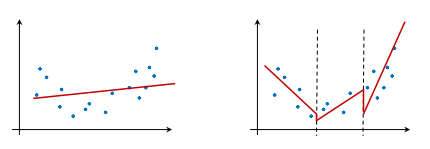Another approach is to construct a set of regression models, each on its own part of the data. The following diagram shows the main difference between a regression model and a regression tree. A regression model constructs a single model that best fits all of the data. A regression tree, on the other hand, constructs a set of regression models, each modeling a part of the data, as shown on the right-hand side. Compared to the regression model, the regression tree can better fit the data, but the function is a piece-wise linear plot, with jumps between modeled regions, as seen in the following diagram:

A regression tree in Weka is implemented within the M5 class. The model construction follows the same paradigm: initialize the model, pass the parameters and data, and invoke the buildClassifier(Instances) method, as follows:
import weka.classifiers.trees.M5P;
...
M5P md5 = new M5P();
md5.setOptions(new String[]{""});
md5.buildClassifier(data);
System.out.println(md5);
The induced model is a tree with equations in the leaf nodes, as follows:
M5 pruned model tree:
(using smoothed linear models)
X1 <= 0.75 :
| X7 <= 0.175 :
| | X1 <= 0.65 : LM1 (48/12.841%)
| | X1 > 0.65 : LM2 (96/3.201%)
| X7 > 0.175 :
| | X1 <= 0.65 : LM3 (80/3.652%)
| | X1 > 0.65 : LM4 (160/3.502%)
X1 > 0.75 :
| X1 <= 0.805 : LM5 (128/13.302%)
| X1 > 0.805 :
| | X7 <= 0.175 :
| | | X8 <= 1.5 : LM6 (32/20.992%)
| | | X8 > 1.5 :
| | | | X1 <= 0.94 : LM7 (48/5.693%)
| | | | X1 > 0.94 : LM8 (16/1.119%)
| | X7 > 0.175 :
| | | X1 <= 0.84 :
| | | | X7 <= 0.325 : LM9 (20/5.451%)
| | | | X7 > 0.325 : LM10 (20/5.632%)
| | | X1 > 0.84 :
| | | | X7 <= 0.325 : LM11 (60/4.548%)
| | | | X7 > 0.325 :
| | | | | X3 <= 306.25 : LM12 (40/4.504%)
| | | | | X3 > 306.25 : LM13 (20/6.934%)
LM num: 1
Y1 =
72.2602 * X1
+ 0.0053 * X3
+ 11.1924 * X7
+ 0.429 * X8
- 36.2224
...
LM num: 13
Y1 =
5.8829 * X1
+ 0.0761 * X3
+ 9.5464 * X7
- 0.0805 * X8
+ 2.1492
Number of Rules : 13
The tree has 13 leaves, each corresponding to a linear equation. The preceding output is visualized in the following diagram:

The tree can be read similarly to a classification tree. The most important features are at the top of the tree. The terminal node, the leaf, contains a linear regression model explaining the data that reaches this part of the tree.
An evaluation will provide the following results as output:
Correlation coefficient 0.9943
Mean absolute error 0.7446
Root mean squared error 1.0804
Relative absolute error 8.1342 %
Root relative squared error 10.6995 %
Total Number of Instances 768